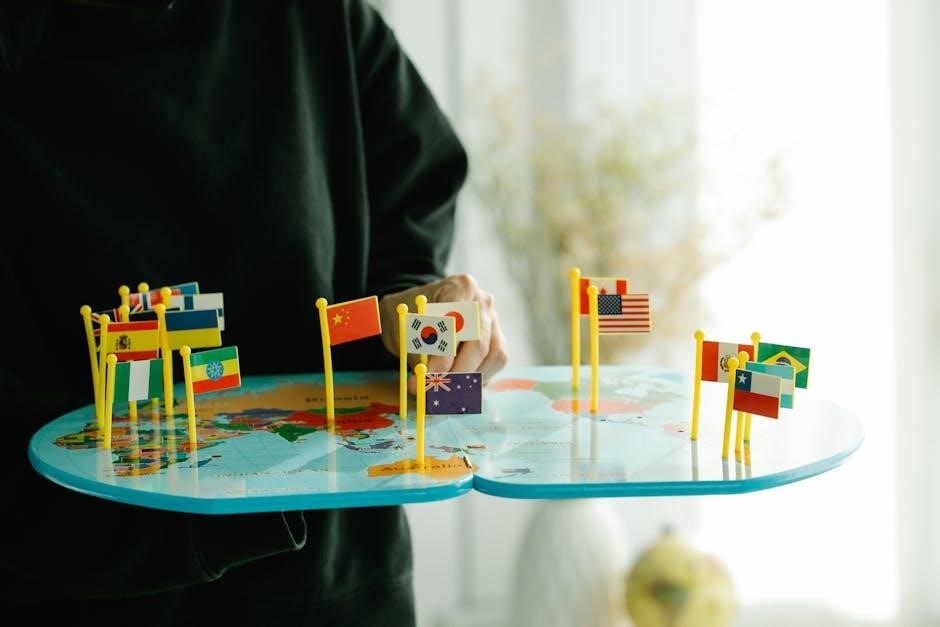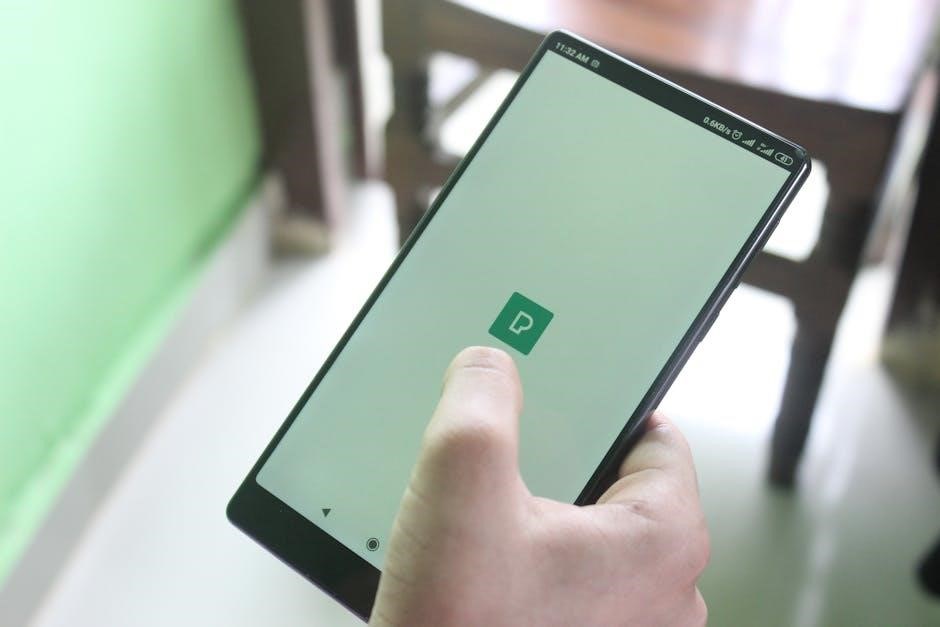Icons are visual symbols that communicate ideas‚ actions‚ or objects in a universal language. They simplify user interfaces‚ enhance recognition‚ and provide intuitive navigation across digital platforms. Icons bridge language barriers‚ making them essential for global communication and design consistency. Their evolution reflects technological advancements and shifting design trends‚ ensuring they remain relevant and impactful in modern interfaces.
Importance of Icons
Icons play a crucial role in enhancing user experiences by providing clear‚ concise‚ and intuitive visual communication. They simplify complex information‚ aiding quick decision-making and navigation. Icons are essential for accessibility‚ as they transcend language barriers‚ making interfaces understandable globally. Their visual appeal strengthens brand identity and user engagement. By combining aesthetics with functionality‚ icons ensure seamless interaction across digital platforms. Their importance lies in their ability to convey meaning effortlessly‚ making them indispensable in modern design systems.
Universal Recognition of Icons
Icons transcend language barriers‚ making them universally recognizable and accessible. Their simplicity and visual clarity enable instant comprehension across cultures and languages. Universal recognition stems from their ability to represent concepts through intuitive visuals‚ such as emojis or traffic signs. This consistency ensures that users worldwide can interpret icons similarly‚ fostering seamless communication. The use of standardized shapes and colors further enhances their universal appeal‚ making icons a common visual language in global design systems.
Evolution of Icon Design
Icon design has evolved significantly‚ from simple symbols to detailed graphics. Early icons were basic and functional‚ while modern designs emphasize aesthetics and usability. The rise of digital tools like Adobe Illustrator and Figma has enabled intricate details and precision. Material Design Guidelines introduced standardized systems‚ ensuring consistency across platforms. Icons now blend simplicity with emotional appeal‚ adapting to trends like minimalism and 3D effects. This evolution reflects technological advancements and shifting user needs‚ ensuring icons remain relevant and effective in communication.

Principles of Icon Design
Effective icon design relies on clarity‚ simplicity‚ and consistency. Icons should convey meaning instantly‚ using minimal elements to ensure legibility and universal understanding across diverse interfaces and cultures.
Clarity of Meaning
Clarity of Meaning
Clarity of meaning is essential for effective icon design. Icons must instantly communicate their purpose‚ balancing aesthetics with function. Simple‚ intuitive designs ensure universal understanding‚ avoiding ambiguity. Use minimal elements and avoid clutter to maintain legibility. Ensure icons are recognizable across cultures and languages‚ leveraging common visual metaphors. Testing icons with diverse users helps refine their meaning. Iterating based on feedback ensures icons convey their intended message clearly. Clear icons enhance user experience‚ making interfaces more intuitive and accessible. Universal recognition ensures icons are effective across global audiences and varying contexts.
Visual Clarity (Readability)
Visual clarity ensures icons are easily recognizable and readable at various sizes and resolutions. Use a standard 24dp size for touch targets and ensure adequate spacing to avoid overcrowding. Designs should remain legible when scaled down‚ avoiding overly intricate details. Favor simplicity and consistent styling across icon sets. Test icons across different screen sizes and devices to ensure uniform appearance. Iterating based on user feedback helps refine visual clarity‚ making icons more accessible and universally understandable. Clear visual hierarchy enhances readability‚ ensuring icons are functional and aesthetically appealing in any interface.
Simplicity in Design
Simplicity in icon design ensures clarity and ease of recognition. Use basic shapes and minimal details to avoid clutter. Avoid overly complex elements that may confuse users. Favor universal forms that transcend language barriers. Ensure icons are scalable without losing meaning. Maintain consistency in style and proportions across icon sets. Avoid excessive lines or intricate patterns. Focus on essential features that convey the icon’s purpose. Simplicity enhances visual clarity‚ making icons more intuitive and user-friendly. It also supports brand consistency and recognition across diverse platforms and interfaces.
Consistency in Style
Consistency in icon design ensures a unified visual language across interfaces. Use a standardized grid‚ such as 16×16 pixels‚ to maintain proportions. Apply uniform stroke weights‚ corner radii‚ and color palettes. Align icons within a baseline grid for visual harmony. Ensure all icons follow the same style guide‚ whether flat‚ outlined‚ or filled; Consistency enhances scalability and recognition‚ while also supporting brand identity. It helps users quickly understand the purpose of each icon‚ fostering a seamless and intuitive experience across platforms and devices.
Scalability
Scalability ensures icons remain clear and legible across various sizes and resolutions. Use vector shapes to maintain quality when resizing. Design icons within a grid system‚ like 16×16 pixels‚ to ensure consistency. Avoid excessive details that may blur at smaller sizes. Test icons at multiple scales‚ such as 24dp and 48dp‚ to verify visual integrity. Scalable icons adapt seamlessly to different devices and screen resolutions‚ ensuring a consistent user experience. This adaptability is crucial for modern interfaces‚ where icons must function effectively on everything from mobile devices to high-resolution displays.
Emotional Appeal
Emotional appeal in icon design creates a connection with users‚ enhancing their experience. Icons should evoke positive feelings through thoughtful use of color‚ shape‚ and style. Color psychology plays a key role‚ as hues like blue can convey trust‚ while green suggests growth. Simple yet expressive designs ensure icons are both functional and visually pleasing. Balancing aesthetics with usability ensures emotional appeal without compromising clarity. Icons that resonate emotionally strengthen brand identity and user satisfaction‚ making interfaces more engaging and memorable.

Icon Design Process
The icon design process involves planning‚ sketching‚ and refining concepts using tools like Adobe Illustrator. Iteration and feedback refine designs‚ ensuring clarity and functionality in the final output.
Planning and Conceptualization
Planning and Conceptualization
Planning and conceptualization are the foundation of icon design‚ involving defining the purpose and audience. Understanding user needs ensures icons align with functionality and brand identity. Brainstorming sessions generate ideas‚ while rough sketches explore visual representations. Researching existing icons provides inspiration and avoids redundancy. Design principles like clarity and simplicity guide the creative process. Establishing a consistent style early ensures cohesion across the icon set. This phase also involves selecting tools and setting up grids for precise design. Proper planning leads to effective‚ intuitive‚ and visually appealing icons.
Sketching and Iteration
Sketching and Iteration
S sketching and iteration are critical steps in refining icon concepts. Starting with rough sketches allows exploration of shapes and ideas. Iteration involves refining these sketches‚ ensuring simplicity and clarity. Using tools like Adobe Illustrator or Figma‚ designers experiment with vector shapes and proportions. Multiple versions are created to test legibility and visual appeal. Feedback is incorporated to adjust details‚ ensuring alignment with design principles. This process ensures icons are intuitive‚ consistent‚ and visually effective‚ ultimately leading to polished‚ user-friendly designs.
Using Icon Design Tools (Adobe Illustrator‚ Figma)
Using Icon Design Tools (Adobe Illustrator‚ Figma)
Adobe Illustrator and Figma are essential tools for icon design‚ offering precise control over vector shapes and scalability. Illustrator’s grid system and Smart Guides enable alignment and proportion accuracy‚ while Figma’s real-time collaboration streamlines teamwork. Both tools support vector-based designs‚ ensuring icons remain crisp at any size. Features like outline mode and stroke adjustments allow for fine-tuning details. These platforms are indispensable for creating consistent‚ high-quality icons that align with design systems and brand guidelines‚ making them vital for modern UI/UX workflows.

Material Design Guidelines
Material Design Guidelines provide a comprehensive framework for creating consistent‚ intuitive icons. Developed by Google‚ they emphasize clarity‚ simplicity‚ and scalability‚ ensuring icons align with modern design systems and user expectations.
Overview of Material Design Icons
Overview of Material Design Icons
Material Design Icons‚ developed by Google‚ are a comprehensive set of visual elements designed to align with Material Design principles. These icons follow strict guidelines to ensure consistency‚ clarity‚ and scalability across various platforms. Created on a 16×16 pixel grid‚ they maintain visual harmony and readability at different sizes. The icons emphasize simplicity‚ using clean lines and minimal details to convey meaning universally. They support multiple formats and are adaptable to different themes‚ ensuring versatility in digital interfaces. This systematized approach makes them a cornerstone of modern UI design‚ enhancing usability and aesthetic appeal.
Icon Grid and Size Specifications
Icon Grid and Size Specifications
Material Design Icons are built on a 16×16 pixel grid‚ ensuring consistency and scalability. Standard icon sizes include 24dp for system icons‚ with touch targets of 48dp for better usability. Icons must fit within the “live area” to avoid being cropped. Pixel-perfect accuracy is achieved by designing for 100% scale. These specifications ensure visual harmony‚ legibility‚ and proper spacing‚ making icons functional and aesthetically pleasing across devices and interfaces. Adhering to these guidelines guarantees a cohesive and professional design language.
Color and Typography in Icons
Color and Typography in Icons
Color and typography in icons play a crucial role in enhancing visual appeal and communication. Using a single color‚ like black‚ ensures simplicity and avoids complexity. Color psychology influences user perception‚ with certain hues evoking specific emotions. Typography should be simple and consistent‚ avoiding multiple styles to maintain clarity. Proper spacing and legibility are key‚ ensuring icons are easily recognizable. These elements together create a cohesive and professional design‚ enhancing the overall user experience while maintaining functionality and aesthetic balance.

Technical Specifications
Technical specifications ensure icons are functional and consistent. Use a 16×16 pixel grid for design and 48dp touch targets for 24dp icons. Optimize for 100% scale.
Standard Icon Sizes
Standard Icon Sizes
Standard icon sizes ensure consistency and usability across interfaces. Common sizes include 24x24dp for system icons‚ 48x48dp for larger targets‚ and 16×16 pixels for detailed designs. Icons should be optimized for 100% scale to maintain clarity. Using a 16-pixel grid helps align elements precisely‚ while touch targets of 48dp ensure accessibility. Consistency in sizing across platforms enhances user experience and ensures icons are recognizable and functional. Proper sizing balances aesthetics with usability‚ making interfaces intuitive and visually appealing.
File Formats for Icons (SVG‚ PNG‚ ICO)
File Formats for Icons (SVG‚ PNG‚ ICO)
Icons are available in various file formats‚ each suited for specific use cases. SVG (Scalable Vector Graphics) offers high-quality scaling and is ideal for web and high-resolution displays. PNG (Portable Network Graphics) supports transparency and is widely used for its versatility across platforms. ICO is the standard format for Windows icons‚ allowing multiple sizes and bit depths in one file. Choosing the right format ensures compatibility‚ performance‚ and visual consistency across different devices and applications.
Accessibility in Icon Design
Accessibility in Icon Design
Accessibility in icon design ensures that icons are usable by everyone‚ including those with disabilities. Clear visual hierarchy‚ high contrast ratios‚ and proper color choices enhance legibility. Icons should be compatible with assistive technologies like screen readers‚ using ARIA labels for semantic meaning. Providing alternative text for icons improves screen reader compatibility. Ensuring touch targets are adequately sized and spaced supports users with motor impairments. Designing with accessibility in mind fosters an inclusive experience‚ making icons functional and understandable for all users‚ regardless of their abilities.

Best Practices for Icon Usage
Consistent icon usage ensures clarity and recognition across platforms. Test icons with users to validate understanding. Iterate designs based on feedback for improvement. Documenting icon libraries helps maintain consistency and simplifies updates‚ ensuring a unified visual language and efficient collaboration among designers and developers.
Testing Icons with Users
Testing Icons with Users
Testing icons with users ensures they are intuitive and universally understood. Conduct usability studies to observe how users interpret and interact with icons. Use A/B testing to compare different designs and gather feedback. Tools like Figma allow prototyping for real-time testing. Analyze user responses to identify confusing or ambiguous icons. Iterate designs based on feedback to improve clarity and effectiveness. Early testing helps refine icons before final implementation‚ ensuring they meet user needs and expectations across diverse audiences and contexts.
Iterating Based on Feedback
Iterating Based on Feedback
Iterating based on feedback is crucial for refining icon designs. Gather insights from user testing to identify areas for improvement. Use tools like Figma or Adobe Illustrator to refine shapes‚ colors‚ and details. Prioritize consistency and clarity while addressing specific user concerns. Each iteration brings the design closer to meeting user needs and expectations. Regular feedback loops ensure icons remain intuitive and visually appealing. This process fosters a design that aligns with both user preferences and brand guidelines‚ enhancing overall user experience and satisfaction.
Maintaining Consistency Across Brands
Maintaining Consistency Across Brands
Maintaining consistency across brands is vital for a cohesive visual identity. Use unified design systems and style guides to ensure icons align with brand guidelines. Apply consistent grid systems‚ color palettes‚ and typography to foster recognition. Scalable icons guarantee uniformity across devices and platforms. Regularly update icon libraries to reflect brand evolution while preserving core design principles. Consistency strengthens brand identity‚ ensuring icons are instantly recognizable and resonate with users across all touchpoints.
Documenting Icon Libraries
Documenting Icon Libraries
Documenting icon libraries ensures accessibility and consistency across teams. Maintain detailed records of each icon’s purpose‚ usage‚ and design specifications. Use version control systems to track updates and changes. Organize icons into categorized folders with clear naming conventions; Provide style guides and usage examples to guide implementation. Ensure documentation is easily searchable and accessible to all team members. Regular updates and cross-references help maintain accuracy. Well-documented libraries streamline workflows‚ reduce errors‚ and promote collaboration‚ ensuring icons are used effectively and consistently across projects.

Balancing Aesthetics and Functionality
Icons must balance visual appeal with usability‚ ensuring they are both attractive and functional. Simplistic designs enhance clarity‚ while thoughtful color and form ensure intuitive user interaction.
The Role of Color Psychology
Color psychology plays a vital role in icon design‚ influencing user emotions and perceptions. Different hues evoke distinct feelings‚ such as blue for trust‚ green for growth‚ and red for urgency. Icons leveraging color psychology effectively communicate their purpose while aligning with brand identity. It’s essential to ensure color choices are accessible‚ with sufficient contrast for readability. Additionally‚ colors should remain consistent across varying icon sizes to maintain clarity and emotional impact. Well-chosen colors enhance both aesthetic appeal and functional effectiveness in icons.
Combining Form and Function
Effective icon design balances aesthetics and usability‚ ensuring icons are both visually appealing and functional. A well-designed icon should convey meaning intuitively while aligning with its intended purpose. Form refers to the visual appeal‚ including shape‚ color‚ and style‚ while function focuses on clarity and usability. Together‚ they create icons that enhance user experience‚ providing intuitive navigation and emotional engagement. By adhering to design systems and grids‚ icons maintain consistency while adapting to various interfaces‚ ensuring scalability and accessibility across different platforms and devices.
Icons are essential for effective communication in design‚ balancing aesthetics and functionality. By adhering to design systems and scalability principles‚ icons enhance user experience and ensure clarity. Continuous learning and adaptation to evolving trends are key to mastering icon design and creating intuitive‚ impactful visual language.
Summarizing Key Points
Effective icon design revolves around clarity‚ simplicity‚ and consistency‚ ensuring universal recognition and intuitive navigation. Key principles include legibility‚ scalability‚ and emotional appeal‚ while adhering to design systems and accessibility standards. The design process involves planning‚ sketching‚ and iterating‚ often using tools like Adobe Illustrator. Material Design Guidelines emphasize grid-based layouts‚ color harmony‚ and typography alignment. Testing icons with users and iterating based on feedback ensures relevance and usability. Documenting icon libraries and maintaining consistency across brands are crucial for cohesive design systems. These practices collectively enhance user experience and communication.
Encouraging Continued Learning
Continuous learning is essential for mastering icon design. Explore tutorials on Adobe Illustrator and Material Design Guidelines to refine your skills. Engage with design communities and forums for inspiration and feedback. Experiment with new tools and techniques to stay updated with industry trends. Practice creating icons for various contexts to improve adaptability. By dedicating time to learning and growth‚ you can develop a deeper understanding of icon design principles and stay ahead in the ever-evolving field of visual communication.
Additional Resources
Explore recommended tools like Adobe Illustrator and Figma for icon design. Join icon design communities and forums for inspiration‚ feedback‚ and staying updated on trends.
Recommended Tools and Tutorials
Recommended Tools and Tutorials
Popular tools for icon design include Adobe Illustrator‚ Figma‚ and Sketch‚ offering advanced vector editing capabilities. Tutorials on these platforms provide step-by-step guidance for creating icons. Google’s Material Design Icons and Font Awesome are excellent resources for inspiration and pre-designed assets. Online courses on Udemy and Coursera cover icon design principles and practical applications. YouTube channels like “Design with Josh” and “The Net Ninja” offer free tutorials for mastering icon creation. Additionally‚ icon libraries like Icons8 and Iconfinder provide ready-to-use icons for various projects.
Icon Design Communities and Forums
Icon design communities and forums are vital for collaboration‚ feedback‚ and inspiration. Platforms like Dribbble and Behance showcase iconic designs‚ fostering creativity and networking. Reddit’s r/icondesign and Stack Overflow host discussions on best practices and problem-solving. GitHub communities share open-source icon libraries‚ promoting collaboration. These forums provide valuable resources‚ feedback opportunities‚ and updates on design trends‚ helping designers refine their craft and stay connected with industry professionals.

No Responses